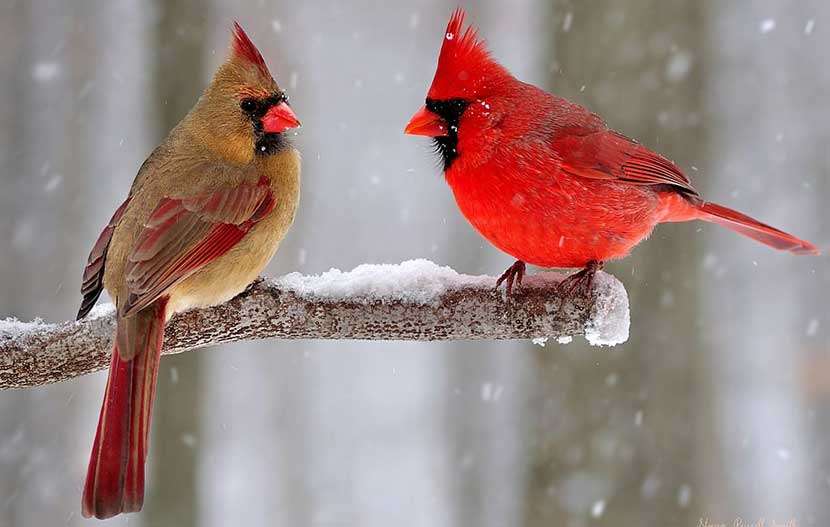SCORES & OUTDOORS: Goal of attracting cardinals finally realized
 by Roland D. Hallee
by Roland D. Hallee
My wife has been trying to attract cardinals to our feeders at home for quite some time. Last Sunday she got her wish when a pair of cardinals came in search of food. First, the female showed herself by clinging to a feeding station. A couple of minutes later, the male appeared. I had told my wife when she first saw the female that, for sure, the male was not far away. When you see one cardinal, the mate is always nearby.
It prompted a conversation about how over the last few decades, the northern cardinal, which was rarely ever seen in this part of the country, has become more abundant.
In John James Audubon’s day (1785-1851), the Northern Cardinal was considered a southern bird and was rarely seen as far north as Philadelphia. By 1895, its range reached the Great Lakes, and by 1910, the cardinal was in southern Ontario and along the southern portions of the Hudson River. Some authorities believe the cardinal’s push northward was due to more people feeding birds during the winter and their loss of habitat in its traditional southern grounds.
Today the Northern Cardinal is a year-round resident from the Dakotas, southern Ontario and Nova Scotia south to the Gulf Coast, and from southern Texas westward through Arizona and southward through Mexico as far as Guatemala and Honduras. The Northern Cardinal was introduced in Hawaii in 1929 and is now well-established there. It also occurs sparingly in southeastern California and in Bermuda as an introduced species.
Although nonmigratory, cardinals often gather in large flocks of up to 70 birds during winter months and can be found in bushy thickets in the more sheltered areas of their range.
Northern Cardinals feed by hopping around on the ground and securing food from low shrubbery and trees. Cardinals’ short, heavy, reddish beaks crack seeds with strong abductor muscles that enable them to handle larger and tougher seeds that birds with smaller bills cannot crack. The grooved upper mandible holds the sunflower seed while the sharp-edged lower mandible moves forward and crushes and husks the seed. The bird then swallows the inner nutmeat.
Most authorities believe Northern Cardinals mate for life, but during winter, the male does not allow his mate to feed with him. With the return of spring, however, he regards her in a new light. Then you see the practice of mate-feeding when the male brings shucked sunflower seeds and other choice tidbits to the female. She waits with her wings all aflutter like a baby bird begging for food, and he places the seed in her bill as tenderly as a first kiss between lovers.
Northern Cardinals will eat almost anything offered at feeding stations. Their favorite foods are black-oil sunflower seed, cracked corn, suet, suet mixes, nutmeats of all kinds, melon seeds and safflower seed. The birds’ diet consists of 30 percent insects, which makes cardinals highly valuable to farmers and gardeners. They consume some of the worst agricultural pests: codling moths, cotton cutworms, scale insects, cotton bollworms, grasshoppers, aphids, snails and slugs.
Although cardinals prefer to eat on the ground, they will come to bird tables, trays on posts and trees, window trays, and hanging feeders with perches.
Water for drinking and bathing is just as important for Northern Cardinals in winter as it is during hot months. Remember to keep the water in your birdbath fresh and unfrozen year-round. Because wet cardinals cannot fly quickly to safety, place your birdbath near cover so the birds can escape from cats and other predators. When birdbaths are not available, cardinals bathe in shallow edges of ponds and streams, in snowmelt or in a puddle after rain. Like children, cardinals enjoy bathing in the spray of lawn sprinklers.
Northern Cardinals prefer brushy woodlands, riparian thickets, garden shrubbery, residential areas and parks.
Cardinal nests are compact and well-lined with fine grass or hair, or they might be flimsy and scarcely lined. The birds often use grass, rootlets, weed stems, pliable twigs, vines and bark strips, interwoven with leaves and paper or plastic. Once, when a storm blew the nest out of a bush, a strip of plastic was found in it with the green recycle symbol printed on it. This pair of Northern Cardinals taught me that humans are not the only creatures to use recyclable materials in their homes.
The cardinals have been appearing daily, and it’s our hope they will continue through the summer months.
Roland’s trivia question of the week:
Name the only three MLB players to have accumulated at heast 500 home runs and 600 doubles during their career.
Responsible journalism is hard work!
It is also expensive!
If you enjoy reading The Town Line and the good news we bring you each week, would you consider a donation to help us continue the work we’re doing?
The Town Line is a 501(c)(3) nonprofit private foundation, and all donations are tax deductible under the Internal Revenue Service code.
To help, please visit our online donation page or mail a check payable to The Town Line, PO Box 89, South China, ME 04358. Your contribution is appreciated!



Leave a Reply
Want to join the discussion?Feel free to contribute!